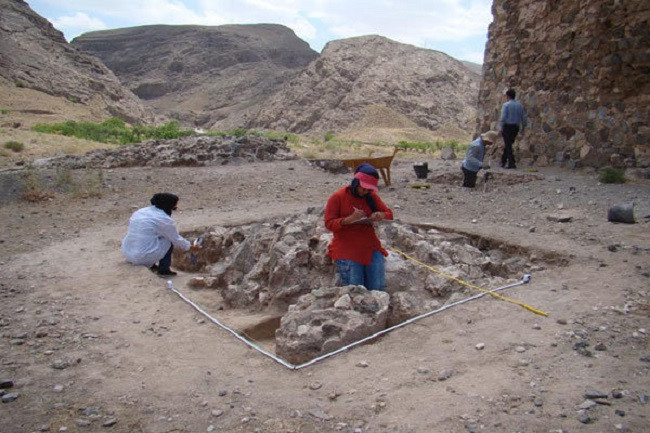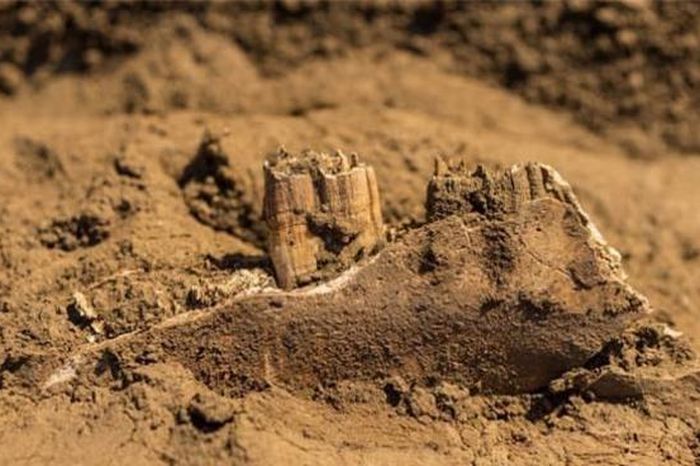Many Sassanid ceramics were excavated at Bazeh Hoor, Mashhad
Archaeologists have found a number of ceramics in Bazeh Hoor, Mashhad in the Sassanid and Muslim periods of the early period (from 224 to 651 AD).
Meysam Labbaf Khaniki, who led the excavation at the Bazeh Hoor area in Mashhad, said that many collapsed pillars were discovered showing the existence of a structure east of Chahartaqi - a structure created on The four suspects may be the remains of Sassanid religious relics and temples.

"The objects discovered show that this building is similar to Chahartaqi, built of stone and plaster, on an area of 250 square meters," he continued.
The archaeologist also noted that part of the excavation of this period was taken into account to determine the settlement south of Chahartaqi. According to him, this area is about 10 hectares, which may include settlements and cemeteries of the early Sassanid and Muslim periods.
Previously, Bazeh Hoor was known as a stone castle east of the village of Robat Sefid, 70km south of Mashhad in Khorasan Razavi province. It was enrolled in the National Heritage List in 1931, and is considered the oldest castle in the world.
You should read it
- The forgotten medieval village was discovered in St Ishmael
- The plaster statue of King Akhenaten was excavated in Egypt
- Strangely, the 100-year-old village has no mosquitoes, so far there is no explanation
- Find new evidence in the medieval cemetery in Ii Hamina
- When stressed the technology bosses will do nothing to relieve stress
- Two Kannada inscriptions were suddenly found
- Explore the rainbow-colored village of fever in Indonesia
- Prehistoric boats were excavated in India
May be interested
- The unprecedented sayings of Steve Jobs
 in the latest book about steve jobs, portraits of the ceo of apple appear to be different from what the public once knew. in particular, many of his unprecedented meaning statements were also 'excavated'.
in the latest book about steve jobs, portraits of the ceo of apple appear to be different from what the public once knew. in particular, many of his unprecedented meaning statements were also 'excavated'. - Oddly the two ancient skeletons excavated at the cemetery in London are of Chinese origin
 history the ancient roman empire was 'disturbed' when it found two chinese skeletons in this area.
history the ancient roman empire was 'disturbed' when it found two chinese skeletons in this area. - Pre-Hispanic Temple of Wari civilization is found in Peru
 in the temple, they found animal teeth, needles, silver cash, brooches, bottles and ceramic pots.
in the temple, they found animal teeth, needles, silver cash, brooches, bottles and ceramic pots. - Set of three Buddha statues in gold coins found in Yangyang
 according to the japan cultural heritage association, the set of three gold bronze buddha statues believed to be in the three kingdoms period (57 tcn-668) was excavated around the three-story stone temple in yangyang temple, gangwon.
according to the japan cultural heritage association, the set of three gold bronze buddha statues believed to be in the three kingdoms period (57 tcn-668) was excavated around the three-story stone temple in yangyang temple, gangwon. - Unexpectedly excavated the statue of Tiye Queen in Luxor, Egypt
 the statue of the tiye queen just found in egypt is an archaeological story that received the attention of many people.
the statue of the tiye queen just found in egypt is an archaeological story that received the attention of many people. - The ancient Viking coffin was excavated in Norway
 archaeologists in norway believe they have discovered a viking boat buried beneath the city of trondheim.
archaeologists in norway believe they have discovered a viking boat buried beneath the city of trondheim. - A woman's body was exhumed from a thousand-year-old blood coffin leaking thick black water, experts were shocked: Evacuate immediately
 the owner of the thousand-year-old blood coffin excavated in inner mongolia in 2003 is princess yulu jiangu, sister of yelu abaoji of the khitan ethnic group.
the owner of the thousand-year-old blood coffin excavated in inner mongolia in 2003 is princess yulu jiangu, sister of yelu abaoji of the khitan ethnic group. - The 2000-year-old road was excavated at Bet Shemesh
 an ancient 2000-year-old ancient road discovered at bet shemesh received the interest of archaeologists.
an ancient 2000-year-old ancient road discovered at bet shemesh received the interest of archaeologists. - 56 mummified bottles were found at Deir el-Bahari
 a series of mummified vase-like artifacts were found by a research team when excavated at ipi's grave (tt 315) at deir el-bahari in luxor. ipi is an ancient egyptian prime minister and a supervisor of thebes during the amenemhat i era at the beginning of tk xii (early middle ages).
a series of mummified vase-like artifacts were found by a research team when excavated at ipi's grave (tt 315) at deir el-bahari in luxor. ipi is an ancient egyptian prime minister and a supervisor of thebes during the amenemhat i era at the beginning of tk xii (early middle ages). - Discover a 1000-year-old ancient Roman mosaic stone in Cyprus
 the ancient roman stone mosaic reflects a fine-art mosaic civilization and a special community activity culture excavated at sip island, which concerns archaeologists.
the ancient roman stone mosaic reflects a fine-art mosaic civilization and a special community activity culture excavated at sip island, which concerns archaeologists.










 The remains of the bird still have organs left after more than 4,000 years buried under the ice
The remains of the bird still have organs left after more than 4,000 years buried under the ice There are hundreds of caves in Nottingham not yet discovered
There are hundreds of caves in Nottingham not yet discovered Archeology Israel explores ancient Roman history at the Mediterranean port
Archeology Israel explores ancient Roman history at the Mediterranean port Mycenean-era tombs with dozens of evidence were discovered in Salamina
Mycenean-era tombs with dozens of evidence were discovered in Salamina Finding new fossils can represent the world's oldest fungus
Finding new fossils can represent the world's oldest fungus